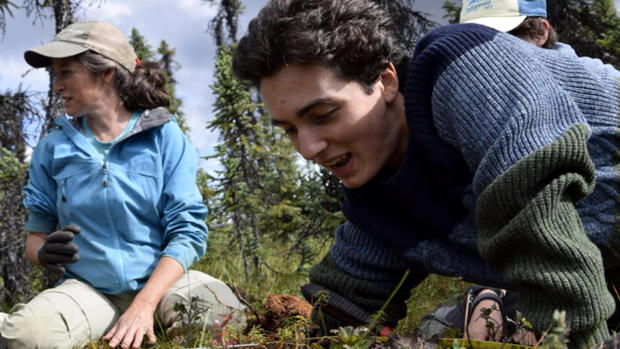Eye On Weather: Students Travel To Alaska For Climate Change Research
BOSTON (CBS) – A group of local high school students traveled to a taiga forest, north of Fairbanks, Alaska this summer. They helped research climate change with scientists from the Woods Hole Research Center.
The group conducted tests on the soil to see how much carbon is being soaked up in permafrost.
Read: Eye On Weather Special Reports
Permafrost is defined as ground that is below freezing for at least two years. Permafrost is only found in the very high latitudes of the Arctic, including portions of Alaska.
"When it thaws, it releases a lot of greenhouse gases into the atmosphere which can effect the climate change and the environment," says Lucy Thompson, senior at Martha's Vineyard Public Charter School.
The Martha's Vineyard Vision Fellowship Grant helped get the six students and one teacher there to do hands-on research.
"We understand the science. And the political science is a little more difficult to get a handle on in that it sort of bumps against people's sort of, hard identity of who they are and what they believe," said Jonah Maidoff, social science teacher at Martha's Vineyard Public Charter School.
"So rather than trying to convince people of the fact of climate change, or it's causes, looking at the metrics, of temp rises or water level or changes in precipitation, and saying, what plans do we put in place. How are we going to deal with this?"
Why Alaska? Climate is changing much more rapidly in the Arctic. Thanks to a permafrost tunnel, researchers can go 14,000 to 40,000 years back in time to see how the climate has changed throughout the centuries.
"Inside it was dry, powdery. This very fine powdery dust. of mineral and organics. And there was a smell in there. Almost like cheese, I suppose. There was ice everywhere. And then sticking out of the wall in one place was a mammoth bone," Maidoff said.
"We could actually see the sheets of permafrost that ran the entire circumference of the sealing of the cave," added Jared Rivard, a senior at Martha's Vineyard Public Charter School.
"If we can share how visual, how real the change is that's happening there is that would be really important," added Lily Tilton, a junior at the school.
These students will be doing additional experiments and data collections on Martha's Vineyard and Cape Cod.
For example, they will be looking at farms and their soil depths, looking at water penetration and how much of the ground water is actually stored.
They will also be making recommendations. One concern is with their hospital.
"We have a road that goes from Tisbury to our hospital, but it's only a few feet above sea level. And if the predictions are correct, that we will have 3-6 feet more water in our oceans by the end of the century or beginning of the next century, then that road is going to have to be 3-6 feet higher. So looking at planning for the future and what we have to do," said Maidoff.
"I think feeling things and seeing them, and touching them makes you understand it a lot better," said Susan Natali, an associate scientist at Woods Hole Research Center.
"Even for myself, I know there's permafrost beneath me when I'm walking around. But when I touch it, I'm still to this day, like 'Wow it's cold down there!' We need the next generation of scientists and business people, the next generation of lawyers to understand what climate change is. and to have that be an important part to their personal decision making."
The students now are encouraged to volunteer with the Woods Hole Research Center. They will have several months' worth of work as they thaw the frozen samples they drilled from Alaska.
Then they need to separate the grass, from the moss, from the plant species.
After that, the scientists will read how much carbon is stored in each section.
Follow Pamela Gardner on Twitter.






